INDUSTRIAL &
TERMINAL RAILROADS &
RAIL-MARINE OPERATIONS
OF BROOKLYN, QUEENS, STATEN
ISLAND, BRONX &
MANHATTAN:
PROCTER &
GAMBLE RAILROAD
Port Ivory, Staten Island, NY
.
.
updated: |
||
|
|
||
update summary: |
date: | |
| 1973 photo of #125 added | 3/6/2012 | |
| undated photo of #125 added | 1/28/2012 | |
.
.

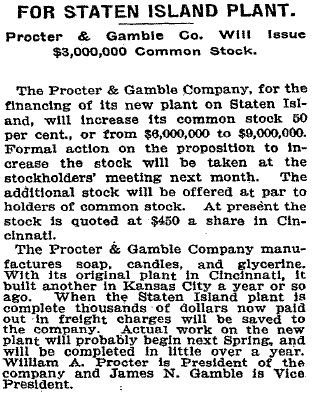
New York Times - October 25, 1905
.
.
History
The Procter & Gamble Company constructed their third factory in the Staten Island neighborhood of Milliken. This plant would begin construction in early 1906, and would open in 1907.
The neighborhood of Milliken would eventually be renamed Port Ivory, in tribute to Ivory Soap, one of the best-known products from Procter & Gamble.
The Procter & Gamble Port Ivory factory was located at Richmond Terrace and Western Avenue. This is in close proximity to the present day Howland Hook Marine Terminal / New York Container Terminal.
A detailed history of Procter & Gamble is available on the world wide web from several sources, so I do not think it is necessary to reiterate the non-railroad history here. Neither will I go into detail about the many dozens of cleaning products Procter & Gamble manufactured at their Port Ivory plant.

Hagstrom - Cruikshank Company - 1949
.
.
The Procter & Gamble Port Ivory plant closed in 1991, however the railroad history of the site does not end there; as a portion of the former Procter & Gamble Port Ivory plant was purchased by the Port Authority in December 2000, rehabilitated, and a ship to rail transfer facility constructed at this location.
The following is a Port Authority of New York and New Jersey press released dated June 28, 2007:
"Cargo containers were transported off the Howland Hook Marine Terminal on Staten Island by rail for the first time today, launching the facility’s ship-to-rail cargo transfer facility. The reactivation of the Staten Island Railroad and the opening of Howland Hook’s ExpressRail Staten Island facility will result in 330 new permanent jobs in the region and the removal of up to 100,000 trucks a year from the Goethals Bridge, and state and local roads.
Port Authority Executive Director Anthony E. Shorris said, “Adding rail cargo capacity to Howland Hook allows us to square a circle – growing our port while helping the environment. In the nation’s most densely populated urban area, getting 100,000 trucks a year off the road is very good news, especially when we can contribute more than $200 million per year to the region’s economy at the same time.”
New York City Economic Development Corporation President Robert C. Lieber said, “This important rail freight system will play a key role in the successful implementation of Mayor Bloomberg’s PLANYC 2030 sustainability program. EDC is pleased to have played an integral part in making the rail service a reality by reactivating the Staten Island Railroad and the rehabilitating the Arthur Kill Lift Bridge.”
The $26 million ExpressRail Staten Island facility was built on a 39-acre parcel on the former Procter & Gamble site, which was purchased by the Port Authority in December 2000.
ExpressRail Staten Island consists of five tracks that are linked to the reactivated Staten Island Railroad. Containers are loaded onto rail cars and transported via the Staten Island Railroad to the Conrail Main Line in Elizabeth, N.J., which connects to the nation’s extensive rail freight network.
The rail facility required the reactivation of the Staten Island Railroad. It also required the rehabilitation of the Arthur Kill Lift Bridge and the construction of a rail link from the bridge to the Chemical Coast line to allow cargo-laden trains access to the national rail freight network.
The ship-to-rail terminal has the capacity to handle up to 100,000 containers per year."
.
It should also be noted, that a draft of this page has been in storage on my computer for two years (prior to release in 2009), awaiting the confirmation of a Procter & Gamble locomotive used at the Port Ivory plant. Procter and Gamble owned many locomotives of various types, which were used at their other plants in Cincinnati and Kansas City, but until Ed Bommer's submission, none could be confirmed to have been used at Port Ivory.
Property & Trackage
It is known that inbound freight arriving at Port Ivory would be brought into Staten Island from New Jersey, by the Baltimore & Ohio Railroad and the Staten Island Railway via the Arthur Kill Lift Bridge.
On the southern border of the property, the trackage of the Procter & Gamble Port Ivory plant was connected to the North Shore Branch of the Staten Island Railway (Baltimore & Ohio Railroad).
Until now (February 12, 2009) it had been undeterminable if the Procter & Gamble plant utilized a float bridge. As there was a track running to the piers located on north shore of Staten Island in the Arthur Kill seen in the 1949 Hagstrom, is would seem logical, but there had been no definitive proof until now.
Then I was fortunate to locate the 1911 Topographical Map below, which answered this float bridge question; as it can clearly be seen in the map and is located at the piers. This map appears to be rather accurate in terms of track layout and structure placement for that period.
At almost the same time that I locate the 1911 Topographical Map, Joe Roborecky (in his usual relentless pursuit of information); located a United States Geological Survey Map (Aerial Photo) of the Port Ivory docks taken in 1954. In this image, a float bridge can be seen!
On 27 June 2010, Jim Guthrie contributed the following map from his collection. It is an excerpt from the 1924 series of the Army Corp of Engineers Port Facilities Map, showing the Procter & Gamble trackage.
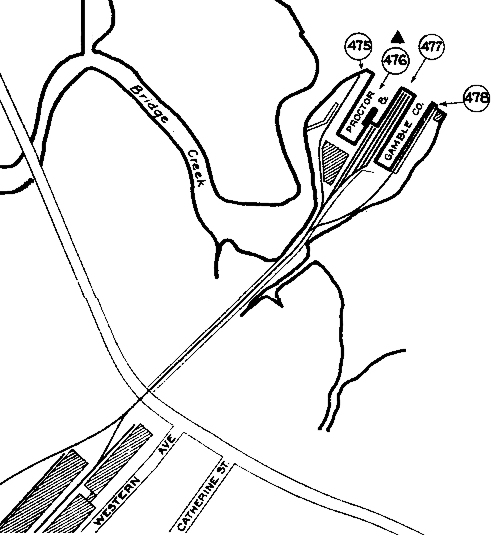
1924 Army Corp of Engineers Port Facilities Map
courtesy of J.
Guthrie
added 27 June 2010
.
.
This float bridge can be also seen in the 1931 version of this photo on historicaerials.com, but it no longer appears in the 1966 version.
So, we are able to conclude that a float bridge was indeed located at Port Ivory from 1911 (and most likely since the plant was construction in 1907) and removed from service between 1954 and 1966.
Before I go any further, it should be understood that there is something unique in the fact that Procter & Gamble operating a float bridge. Considering that Procter and Gamble was not a freight terminal, common carrier or an interchange railroad; and through referencing New York Harbor Terminal Port Facility Maps; Procter & Gamble appears to be one of only two private companies to operate a float bridge in the New York Harbor area.
As far as can be told, there were only two private companies that operated float bridges: Procter & Gamble, and the New York City Transit System, which would operate a float bridge at their 207th Street facility located at Inwood, Manhattan for the purpose of unloading subway cars. A webpage on that facility can be viewed here: 207th St Yard (IND / NYCTA)
The 1911 Topographic Map is shown here:

An inquiry via MSN Live Search Aerial Maps, shows that most of the piers and bulkhead still survive to this day. I have included this image as well for comparison.
|
|
.
.
Seen in the left image, to the left of the curved trackage, is a very tall double silo structure (note length of shadow). It was unknown what purpose this silo served, and what was stored and / or dispensed. According to Charles Gerow, (fellow member of the Rail Marine Information Group), this was a coal silo and that Procter & Gamble maintained a coal depot at Port Ivory. Presumably, the coal was used for heating the buildings, as well as in the manufacturing and rendering processes of the soaps and cleansers, as well as fuel for the locomotive. The foundation of this silo still exists and can be seen in the right aerial image.
The following information was courteously submitted by Ed Bommer:
"Procter & Gamble's float bridge dated from when Port Ivory was first built in 1906 and greatly expanded in the early 1920's. It was in use up through World War II. It's primary purpose was for dispatching loaded cars to other New York area railroads which had direct connections to New England, Great Lakes and Canadian markets. While the Procter & Gamble float bridge was privately owned, it was serviced by the Baltimore & Ohio Railroad / Staten Island Rapid Transit, which also maintained and inspected Procter & Gamble's track scales.
Procter & Gamble had a pier there as well (hence, it was a company owned "port" at Port Ivory). It handled export lighterage, coastal-size tankers and tank barges. It was built with the plant in 1906 for receiving whale oil, which was loaded into tank-barges out in The Narrows from large, steam-powered whaling ships. Lighters and covered barges were loaded with Procter & Gamble's products for export in ships. I recall Amboy Towing Co. tugboats handing some of that traffic up to the late 1940's.
In 1935, Procter & Gamble's float bridge was used to take all the streetcars off Staten Island. The Richmond Railways Route 1, a/k/a Richmond Terrace trolley line, was fitted with a switch and spur connecting to the tracks in Procter & Gamble's carfloat yard. Mack 'bulldog' trucks hauled dead trolleys to that point in cuts of 5 or 6 cars. Procter & Gamble's 0-6-0 steam switcher number 123 (maintained by Staten Island Rapid Transit at their Clifton Shops) did the carfloat loading. Many of those less than 10 year old streetcars went to the Bronx, while others were sent to more exotic places. |
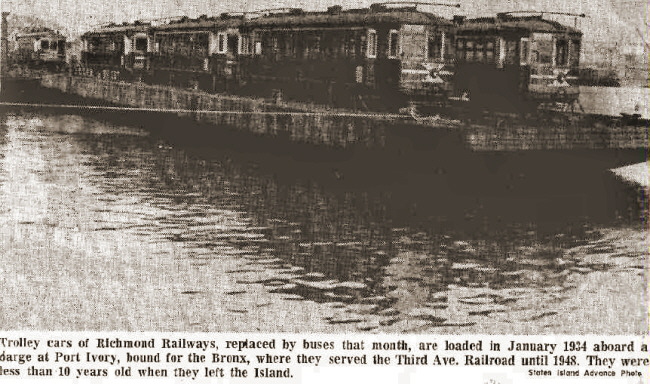 |
Procter & Gamble's switcher and crews received all in-bound cars, moved them about the plant and set-out loaded cars for shipment. In-bounds mainly came to Procter & Gamble via the Baltimore & Ohio Railroad / Staten Island Rapid Transit Arlington Yard. Procter & Gamble shipped its products via Staten Island Rapid Transit through Arlington Yard to the Baltimore & Ohio, Reading, Jersey Central, Pennsylvania and Lehigh Valley Railroads, all with whom Staten Island Rapid Transit had direct rail connections.
To reach New England, Great Lakes area and Canadian markets, loaded cars on floats directly went from Procter & Gamble to the Erie, Delaware Lackawanna & Western, Long Island, and New York Central Railroads in particular, using Baltimore & Ohio Railroad tugs and carfloats. This side-stepped delays that would occur if Procter & Gamble's loaded cars passed back through the busy Staten Island Rapid Transit's Arlington yard, the North Shore line, the St. George Yard for carfloating from there.
Baltimore & Ohio Railroad handled this out-going traffic from Procter & Gamble's own transfer bridge. The productivity of the Port Ivory plant was such that fully-loaded carfloats could be dispatched directly to an interchange connection. This arrangement also facilitated faster delivery of empty cars to Procter & Gamble when needed.
Because of it's location relative to the other carfloating railroads in New York Harbor, it would not have been as economically feasible for them (CNJ, DL&W, ERIE, LIRR, PRR, etc.) to service the Procter & Gamble float bridge as it would the much closer Baltimore & Ohio Railroad / Staten Island Rapid Transit from St. George. Although, in the 1920's , CNJ also had a float bridge near their coal dumping dock at Elizabeth, a bit south of where the 'new' Singer sewing machine plant was located.
As more and more shipments went out by truck after World War II, the float bridge was removed and the Procter & Gamble docks on the Kill van Kull fell into disuse. The tracks were still there on what remained of the Procter & Gamble dock in 2003."
Upon the discontinuation of float bridge service, all railroad transported freight would have to arrive and be shipped via the Baltimore & Ohio Railroad Arthur Kill Lift Bridge and the Staten Island Railway.
The Staten Island Railway would be a subsidiary of the Baltimore & Ohio Railroad until 1971, when at that time the Staten Island Railway became a New York City Transit Authority subsidiary.
The Baltimore & Ohio Railroad would continue to provide freight interchange with Procter & Gamble via the Arlington Yard, where a P&G loco would transfer the cars to P&G sidings.
Sometime in the late 1980's through 1991 (when freight service on this line was discontinued), the New York, Susquehanna & Western Railway (owned by the Delaware & Otsego Corporation) obtained trackage rights to provide freight service on Staten Island on the North Shore Branch. The freight service provided by New York, Susquehanna & Western Railway is believed to have continued until Procter & Gamble closed their Port Ivory plant.
On 01 April 2010, I received a telephone call from Nathan Fenno; president of the New York, Susquehanna & Western Railway in response to an inquiry I made regarding New York, Susquehanna & Western Railway operations in Staten Island.
Mr. Fenno was kind enough to explain the following: the Baltimore & Ohio merged with CSX in 1976, and CSX provided service until 1985, at such time the route was put up for bid. The New York, Susquehanna & Western Railway won the bid and provided freight service for that branch from 1985.
During that time period, the New York, Susquehanna & Western Railway had two customers in Staten Island: Procter & Gamble and US Lines, a shipping line based out of Howland Hook. In 1986, US Lines went bankrupt and Procter & Gamble decided to close the Port Ivory plant in 1991.
With no customers to service the New York, Susquehanna & Western Railway filed for abandonment of the line, which was granted.
This branch was also formerly a passenger line, but passenger service had been discontinued in 1953.
Staten Island Rapid Transit Passenger Service to Procter & Gamble
While not directly pertaining to the freight operations at Procter & Gamble, it is worth mentioning that there was direct passenger rail service to Procter & Gamble.
This passenger service was provided by Staten Island Rapid Transit, which was a subsidiary of the Baltimore & Ohio Railroad. The Baltimore & Ohio Railroad provided freight service to Arlington Yard (almost immediately south of Procter & Gamble) and along the North Branch all the way east to St. George, where the B & O had a modest yard with up to four float bridges and a McMyler coal dumper in it's heyday.
Our own Ed Bommer, this websites' resident B & O historian adds the following information:
Here is a photo of a two car SIRT train at the Procter & Gamble Port Ivory Station, about 1948. It wears an "ARLINGTON" sign, because of the rebuilding of the St. George Terminal after the 1946 fire.

Staten Island Rapid Transit at Procter & Gamble
Platform - circa 1948
Note third rail in shadow below platform to right of steps.
E. Bommer collection
added 28 December 2011
.
Arlington trains had to use either South Beach or Tottenville platforms until the North Shore platforms were finished in 1950. The car end signs let riders know which train was at what platform.
From 1906 to 1952, the SIRT provided & scheduled trains to meet shift changes at Procter & Gamble; and until the early 1920's, neighboring industry Milliken Steel (which became Downey's Shipyard) as well. With the electrification of the line in 1925, the SIRT third rail was extended into Procter & Gamble property for this change of shift service. The Port Ivory Station platform was behind the Procter & Gamble employee cafeteria.
SIRT ran some Arlington trains farther west through the yard to the Western Avenue grade crossing, then into the Procter & Gamble plant yard. The third rail in this photo is next to the platform.
Some have said Procter & Gamble locomotives hauled these cars into Procter & Gamble property because a third rail is not easily seen. But such was not so. I have watched these trains come and go there as a boy. I also have an SIRT employee timetable which contains a diagram for the third rail, electrical cut-out switches and the tracks at Procter & Gamble used by SIRT.
Remains of Procter & Gamble
.
Special thanks is due to:
Frank Rose, (Supervisor of Rail Operations, NYCT),
Gary L. Smith, (PANYNJ Maintenance Unit Supervisor, NY Marine
Terminals) and
Arie Van Tol, (PANYNJ manager of Marine Terminals)
In February 2009, I was on an unscheduled visit to Port Ivory with my co-researcher Joe Roborecky; where we attempted to photograph the remains of the Procter & Gamble facility. I was stopped by an employee of the New York Container Terminal, where photography is forbidden.
As it turned out, the employee was none other than Frank Rose, who formerly worked for New York Cross Harbor Railroad, and knew of a close friend of Joe Roborecky's; Mr. Fred Breimann, who was an engineer and helper for Bush Terminal Railroad and New York Dock Railway (successor to Bush Terminal) and then engineer for the New York Cross Harbor Railroad (successor to New York Dock).
I had previously met Mr. Rose in July 2006, when I was photographing the Greenville, New Jersey, float bridges (former Pennsylvania Railroad) and where Brooklyn Eastern District Terminal was contracted to operate the facility by Conrail, 1976 - 1983. This property is now under the auspices of New York New Jersey Rail.
Mr. Rose is now Supervisor of Rail Operations at the New York Container Terminal, and we recognized each other after a hesitant moment of memory searching. Mr. Rose informed me that an upcoming phase of new construction was being planned for the bulkhead and waterfront area where the Procter & Gamble float bridge was located, which was going to lead to the destruction of the remains. While this portion of the property was not under his supervision, he referred me to Mr. Arie Van Tol of Port Authority of New York & New Jersey.
In April of 2009, I corresponded with Mr. Arie Van Tol, who is the Manager of Marine Terminals for the Port Authority of New York & New Jersey (PANYNJ), in gaining access to the property of the former Procter & Gamble Plant in Port Ivory, Staten Island.
As I had learned that the PANYNJ is gearing up to demolish the piers and former site of the float bridge on the Arthur Kill waterway for new container ship berths sometime within the next few months, I explained to Mr. Van Tol, that it was imperative that I capture these structures on film before being razed.
Mr. Van Tol, expedited my access request (after necessary background checks) and secured same, for both myself and Joe Roborecky, and we were given escorted access to the facility on 01 May 2009.
Unfortunately, Mr .Van Tol who wanted to join us, was going on scheduled vacation. So he left me in the capable company of Mr. Gary L. Smith, who is the Maintenance Supervisor of NY Marine Terminals for PANYNJ. Mr Smith was more than knowledgeable of the history of the facility was able to offer insights to many of the remaining structures (plus getting me over to the Arthur Kill Vertical Lift Bridge to photograph it being lowered and subsequent train crossing with little notice!)
The following images show the remains of those Procter & Gamble structures. All images taken by author on 01 May 2009.
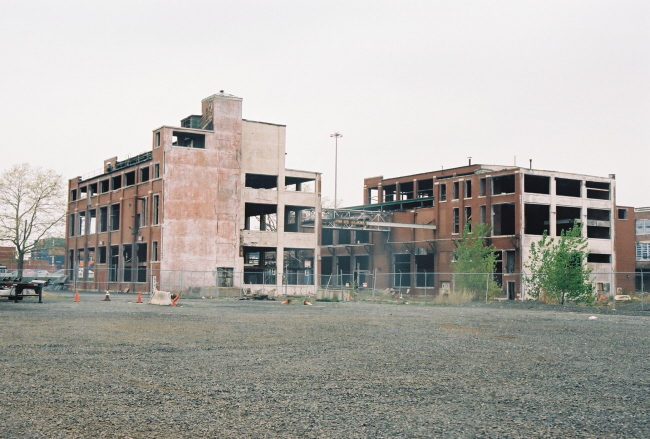 |
| .
. |
|
| .
. |
|
| .
. |
|
| .
. |
|
| .
. |
|
| .
. |
|
| .
. |
|
.
.
In the Main Administrative Building of PANYNJ at Howland Hook; is a diorama of the the Procter & Gamble property. It is encased in a plexiglass bubble and placed in the glass windowed alcove of a staircase leading to the second floor, which makes photography a little difficult. I had to first clean the plexiglass of dust, because as you can imagine, the present day operations have no bearing on the diorama. Gary Smith located some paper towel and some glass cleaner, and I went to work.
However, if one looks closely, someone with a sense of humor put "Hot Wheels" construction equipment around the building, symbolic of the ongoing razing of those buildings!
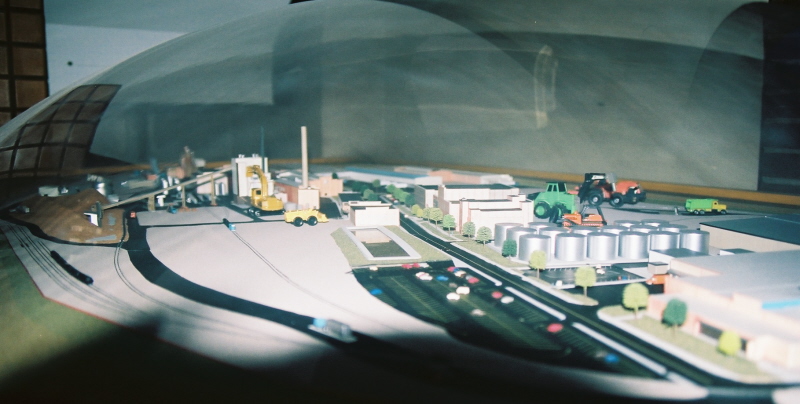 |
| .
. |
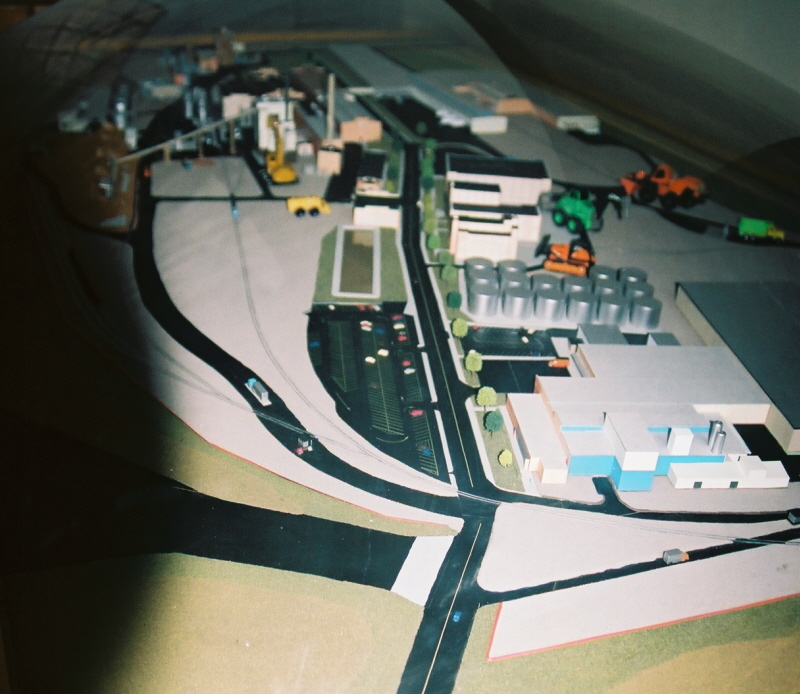 |
The Logo
The logo seen here, was widely used by Procter & Gamble and could be found affixed to the cab sides of the diesel locomotives.

Upon looking for this logo, I happened across some very amusing information. Apparently a rumor was started in the mid 1980's, that this Procter & Gamble logo was a symbol of Satanism. Procter & Gamble spent a great deal of time and effort proving this not to be the case, but I am sure most people know it always more difficult to eradicate or disprove a rumor than it is to start one!
Nevertheless, this logo was phased out in favor of their new corporate logo:
| P&G |
Upon my visit to the Procter & Gamble facility, I took note that the administration building had at one time been adorned with cast concrete versions about three feet in diameter of this logo. But they were "plastered over" with concrete. Truly a shame.
.
Locomotives
To date, there were five known locomotives to be used at the Port Ivory plant of Procter & Gamble. There is a possibility of others.
It is currently unconfirmed if a locomotive was used at this facility between 1907 and 1920, and if so, what locomotive that was; or if Baltimore & Ohio Railroad provided switching services. However, in researching the various locomotive builders records, it is recorded that Baldwin Locomotive Works constructed an 0-4-0T steam locomotive (c/n 32237) in November, 1907 for Procter & Gamble. Coincidentally, 1907 is the same year the Port Ivory facility was completed. Therefore, it is believed that this Baldwin Locomotive (c/n 32237) was used at the Port Ivory facility, but this is not irrefutably confirmed.
The first locomotive to have definitively been used at Port Ivory, was #123, a steam locomotive of 0-6-0 wheel arrangement and with a slope back tender. This locomotive was built by Baldwin Locomotive Works and was built in 1920. This locomotive was purchased new by Procter & Gamble for use at the Staten Island facility.
Procter & Gamble sold #123 to the Southern New York Railroad located in Oneonta, NY and #123 was used to take up the tracks between Herkimer and Oneonta, NY.
The next locomotive to have been used at Port Ivory, was #2. This was a General Electric 23 ton Boxcab locomotive built in June 1939. According to an email I received on 06 January 2010 from Bill McBride:
The other locomotive that you may be looking for was a GE 23 ton box cab built new for P&G's Dallas, TX plant. It was c/n 12494 built 6/39. I don't have details on when it was shipped east.
When P&G acquired the Baldwin, the GE was sent to Acme Steel at South Chicago, IL; where it was used until it was sold for scrap to the Hyman Michaels Co.
The next locomotive confirmed to have been used locomotive: #125, was a Baldwin Locomotive Works model VO-660, was built in 1939. It appears from photograph dating, this locomotive served at this location until 1974.
The fourth locomotive, was an American Locomotive Works model S4, which was purchased second hand from Louisville & Nashville Railroad (#2366) in 1974. The disposition of this locomotive is not recorded but took place between 1983 and 1985.
Also in that email I received from Bill McBride he added this locomotive as well (and actually listed first in the email):
"May I add to your site two photographs of the last locomotive that P&G used at Port Ivory.
The "MUTT" was built by Chattahoochee Locomotive in TN using an Alco frame with Blunt trucks. No further information is available.
A quick web search for Chattahoochee Locomotive revealed that this firm is a low power switcher rebuilder now located in Conyers, Georgia. A look at the photos sent, reveals this locomotive is based on a ALCo switcher frame (S series) and the ALCo "Blunt" style trucks would mean it is from either an S1 or S3 model.
As the ALCo S4 above (#36) was not equipped with Blunt trucks, it is unlikely that #36 was the locomotive used as a base for the Chattahoochee Locomotive rebuilt unit. Also, the Blunt style trucks on that rebuilt locomotive have been converted to roller bearing. But that does not mean they could not have been substituted trucks upon rebuild.
Anyhow, according to Bill, this locomotive served the Port Ivory facility until it's closure in 1991. So, thanks to Bill for adding these locomotives to the Port Ivory Roster!
|
| .
. |
|
| .
. |
|
| .
. |
|
| .
. |
|
| .
. |
|
| .
. |
|
| .
. |
|
| .
. |
|
| .
. |
|
.
.
Proctor & Gamble - Port Ivory, Staten Island - Locomotive Roster
| number / name |
builder |
c/n |
build date |
gauge |
wheel arrangement |
model | wheel dia |
cylinders |
acquired |
disposition |
notes |
ref |
| #1 | Baldwin | 32237 | 11/1907 | std. | 0-4-0T | 44" | 16" x 24" | new | unknown | [2] | ||
| #123 | Baldwin | 52874 | 1/1920 | std. | 0-6-0 | new | sold ca. 1939 to Southern NY Rwy in Oneonta, NY; scrapped 12/1950 |
[2] | ||||
| #2 | GE | 12494 | 6/1939 | std. | B | 23 Ton Boxcab |
new | sold 12/1945 to Acme Steel, S. Chicago,
IL; sold for scrap to Hyman Michaels Co. |
Originally built for Dallas, TX plant. Sent to Port Ivory (to replace #123?) | |||
| #125 | Baldwin | 72819 | 12/26/1945 | std. | B-B | VO660 | new | unknown | 660 hp | [2] | ||
| #36 | ALCo | 80453 | 6/1953 | std. | B-B | S4 | used 5/1974 |
ex-Louisville & Nashville #2366 |
[1] [Rumary] |
|||
| "Mutt" | Chattahoochie Locomotive | std. | B-B | Alco frame with Blunt trucks. |
Like what you see? Suggestions? Comments?